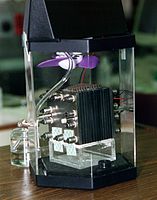
Photo from wikipedia
Abstract Since 2003, the National Fuel Cell Research Center at the University of California, Irvine (UCI) has operated the first U.S. publicly accessible hydrogen refueling station (HRS). During this period,… Click to show full abstract
Abstract Since 2003, the National Fuel Cell Research Center at the University of California, Irvine (UCI) has operated the first U.S. publicly accessible hydrogen refueling station (HRS). During this period, the UCI HRS supported all manufacturers in the early, pre-commercialization years of the fuel cell electric vehicle (FCEV). This paper describes and analyzes the performance of the UCI HRS during the first five years of FCEV commercialization, over which time the station has dispensed the most hydrogen daily in the California network. The station performance is compared to aggregate data published by NREL for all U.S. HRSs. Using the Hydrogen Delivery Scenario Analysis Model, typical daily refueling profiles are analyzed to determine the effect on HRS design. The results show different daily refueling profiles could substantially affect HRS design and ultimately the cost of hydrogen. While technical issues have been reduced, the compressor, dispenser, and fueling rate are areas for improvement.
Journal Title: International Journal of Hydrogen Energy
Year Published: 2020
Link to full text (if available)
Share on Social Media: Sign Up to like & get
recommendations!